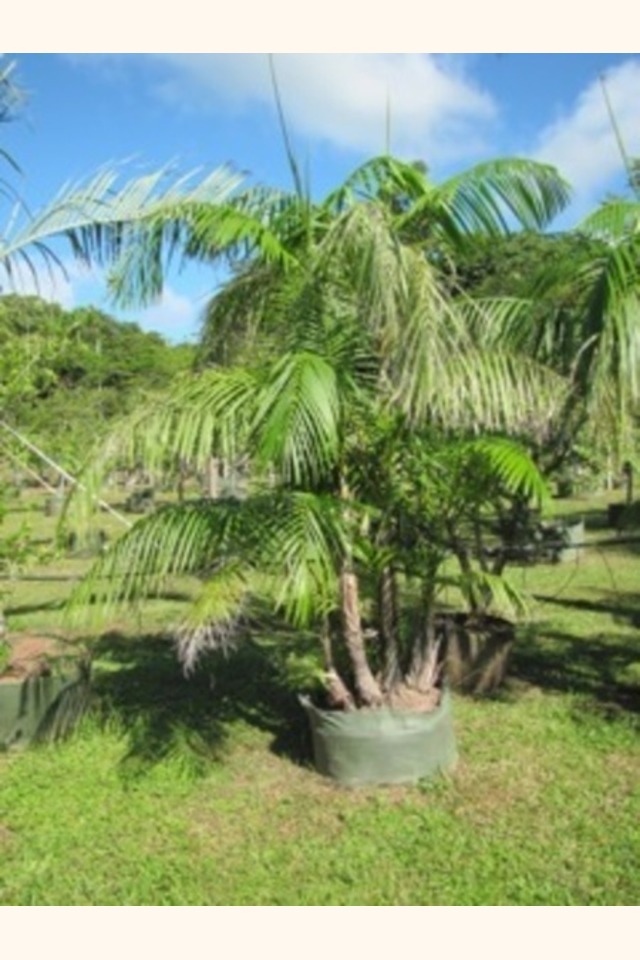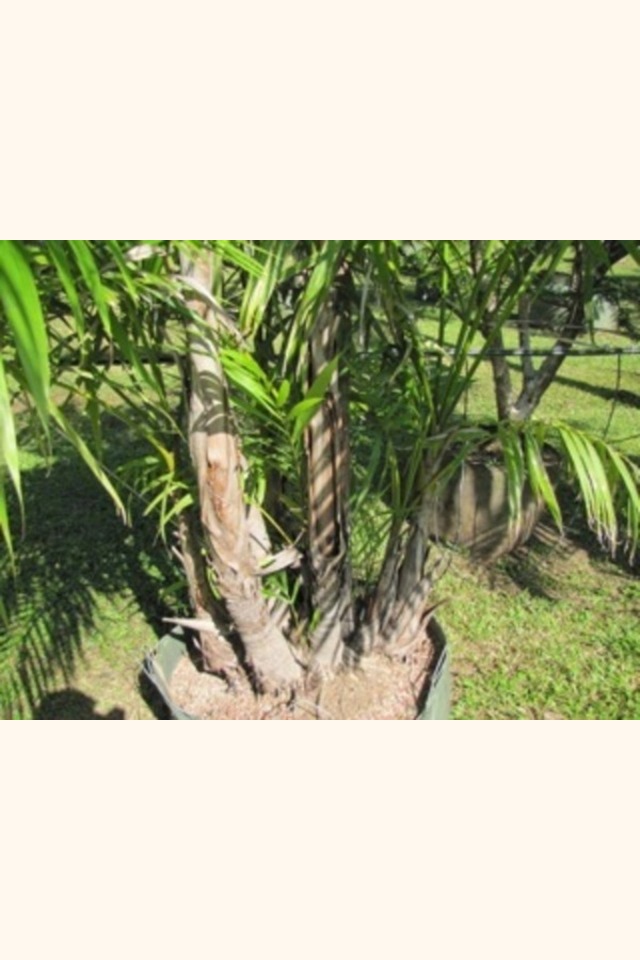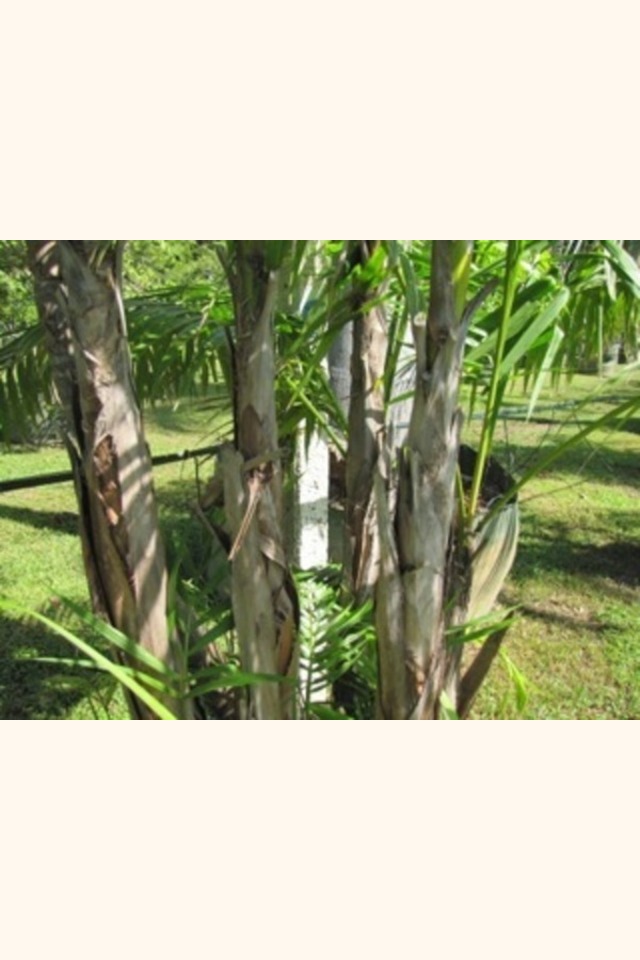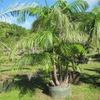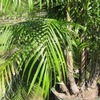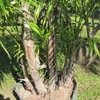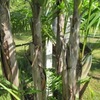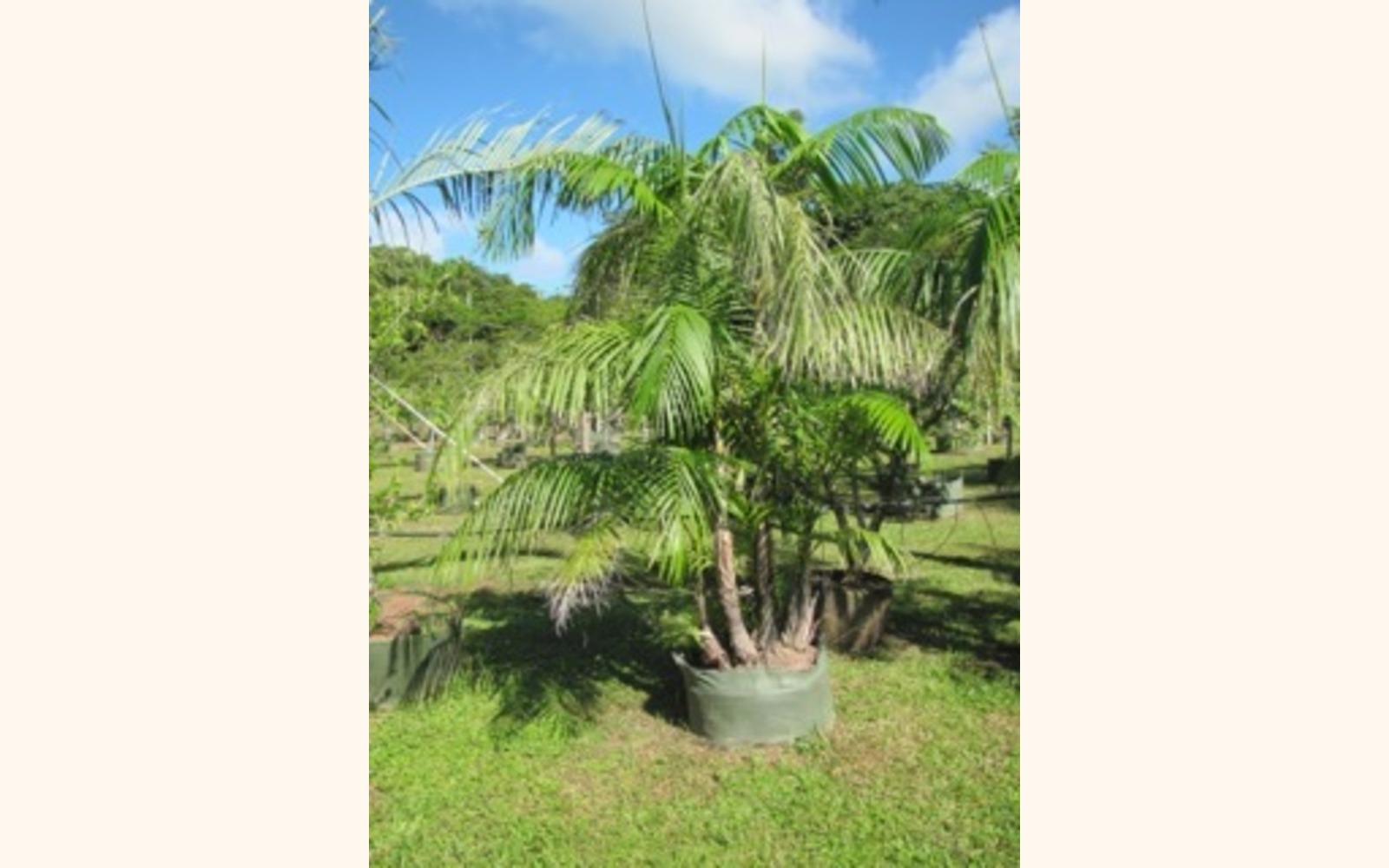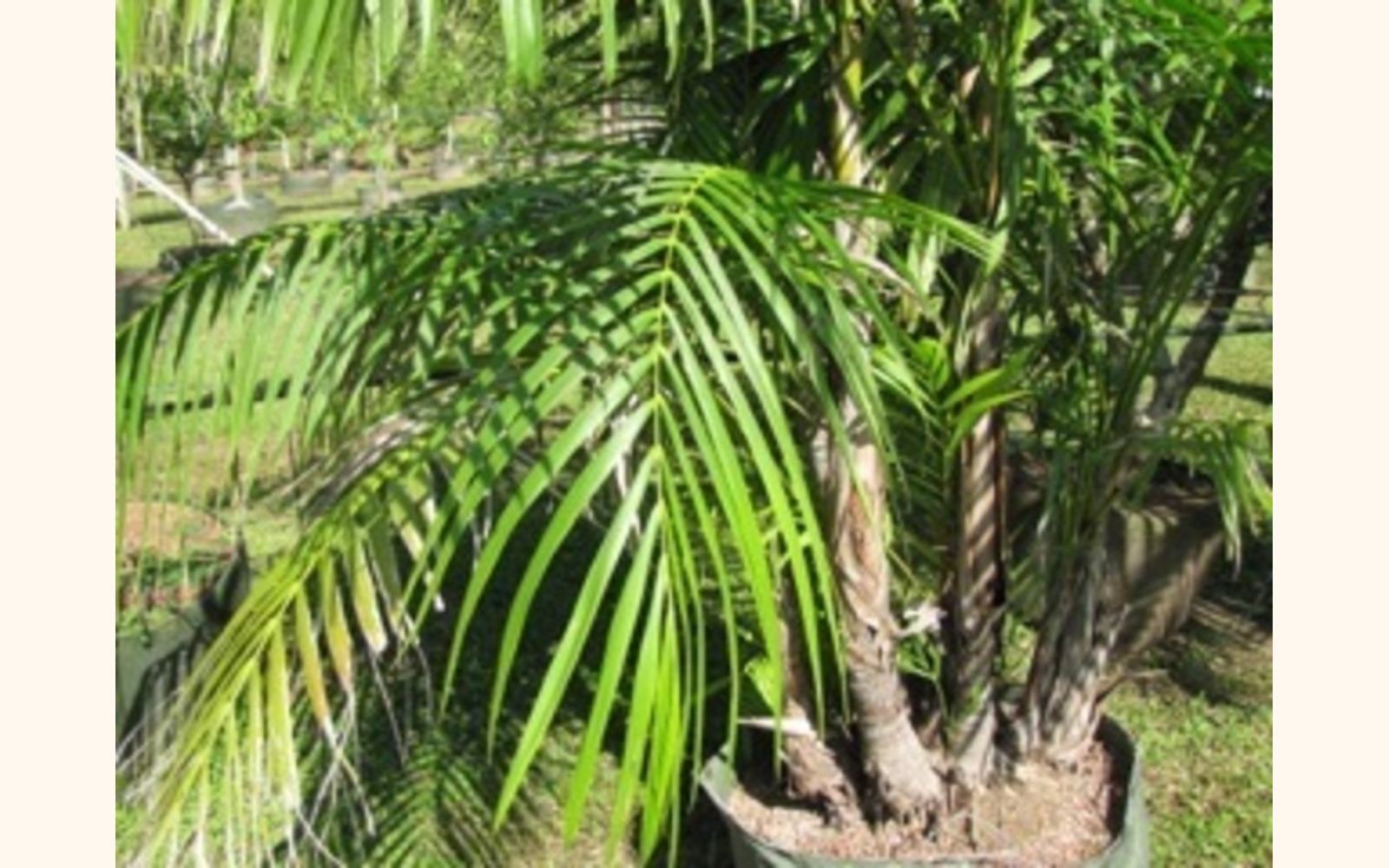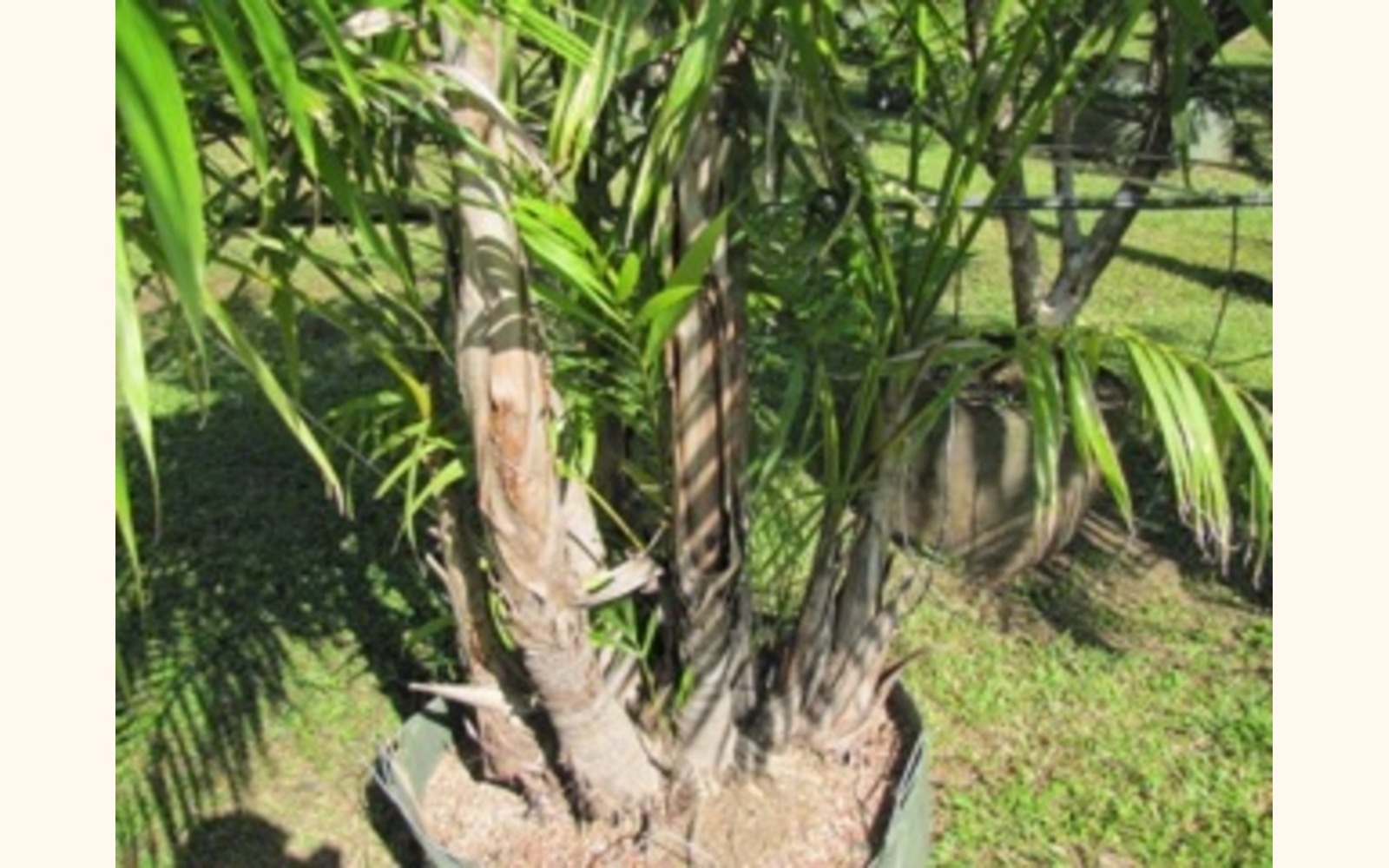
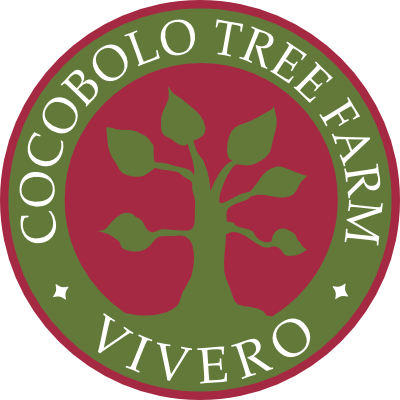
Costa Rican bamboo palm, Parlor palm , Palma Bambu Costa Rica
Trunk type: Clustering?, heavily ringed from leaf scars, to 5 centimeters,(2") in diameter. Height: To 3.6 meters, (12'), cluster to 1.5 meters, (5'). Leaf detail: Pinnately compound, diametrically opposed, closely knit ovoid pinnae, average frond holds up to 60 pinnae. Flower detail: Creamish yellow flower, separate male, and female plants. Flower stalk coming from below the leaves, erect or pendulous. Becoming orange when carrying fruit. Fruit detail: Green turning black when ripe. 0.25 to 0.4 inches in diameter (6 to 10 mm), 0.5 inch long (1.2 mm). round to ellipsoid. A moderate-sized palm, it forms dense clusters of thin, green, cane-like stems that can reach up to 6 m (20 ft.) tall but usually stay much shorter. The crowns hold many dark, glossy green, pinnate leaves. While generally similar to the more commonly seen Bamboo Palm, Chamadorea seifrizii, it grows larger, with longer leaves and has a much more luxuriant appearance. It is native to rainforests from Panama north to Honduras where it grows from tropical 600 m (2000 ft.) to decidedly chilly altitudes at 2300 m (7500 ft.).
Habit: cespitose (growing in tufts or clumps) by means of short horizontal stems at or near ground level, mostly erect but at times eventually leaning and becoming decumbent, forming rather dense or open clumps 3-8 x 3-6 m high. Stems: 2-6 cm in diam., smooth, green, prominently ringed, internodes 5-30 cm long
Oersted (1859) described and named C. costaricana from material he collected in mountain forests about 1,000-1,500 m elevation near Turrialba, Costa Rica during his travels in Central America in the middle of the 19th century. Today, the native forest in this area is virtually gone, having been destroyed long ago for agricultural purposes. A few stands of C. costaricana still exist, though, not far from Turrialba in forest remnants on the slope ofVolcan Barva; we collected it in 1990 near Turrialba on the road to Moravia de Chirripo. Chamaedorea costaricana is a most variable species throughout its rather wide range. Different have been proposed based principally on size and number of parts and prominence of nerves of the pinnae. The description attempts to account for the extremes in size of stems, leaves, pinnae, and inflorescences. Guillaumin (1922) described and named C. biolleyi from material cultivated at the Musee de Paris since 1900 from seeds that Biolley had sent from Costa Rica. Later, Bailey (1943a) described and? named several species of Chamaedorea from Panama that were collected by various members ofthe Missouri Botanical Garden in support of the Flora of Panama. Two of these, C. linearia and C. seibertii, were of interest since their descriptions depicted plants close to C. costaricana although the names have not been applied to material in cultivation. In 1987 and 1990, 1. I had the opportunity to visit various localities in Costa Rica and Panama and to observe C. costaricana in the wild and in cultivation. In Panama I visited the type localities of C. linearia and C. seibertii. In each location I made collections that corresponded well with Bailey's descriptions of these species. Comparison of these with Bailey's types, Oersted's type of C. costaricana, Guillaumin's type ofC. biolleyi, and with various other collections from Panama to Honduras show that, essentially, the differences are of size only. Chamaedorea costaricana is widespread and well represented by collections throughout its range. Galeano and Bernal (1987) reported C. linearia from Colombia although they stated it is single-stemmed and did not mention the ligules at the apex of the leaf sheath. Moore (1975) reported it from Monteverde in northwestern Costa Rica as Chamaedorea sp. # 2. I have also collected C. costaricana in forest remnants near there and at several other localities in Costa Rica and Panama. Generally, there seems to be a relationship between altitude and rainfall and size ofplants. It seems that smaller forms occur in lower altitudes with lower and perhaps more seasonal rainfall while larger forms occur at higher altitudes where rainfall is greater and less seasonal and evaporation less. Above Cerro Punta in western Panama we observed several individuals of a very large form of C. costaricana. Its stems were quite stout, six cm in diameter, but were so long, over 15 m, that they could not support themselves and were snaking up into the branches of taller trees. Bailey's C. linearia typifies the large end ofthe spectrum with plants being larger in every part. At the small end is Bailey's C. seibertii. The typical C. costaricana that Oersted described represents the middle of the spectrum. In his key to Chamaedorea, Bailey (1943b) distinguished between C. seibertii and C. linearia by the former having straight pinnae that were not sigmoid or falcate. The straightness or curvature of pinnae appears to be a variable character. The presence of the two ligules at the apex of the leaf sheath is a diagnostic character unifying all these forms. The ligules are lanceolate and membranous and more or less deciduous, at least in their upper portion. The lower or basal portion is not as membranous and is often persistent as a triangular tooth or auricle one to two cm long after the upper portion has fallen or rotted away. Since the upper portion is membranous and rots away rather rapidly, the overall visibility ofthis appendage is much reduced with time. Therefore, it is best viewed on leafsheaths on the apical portions ofstems near new, emerging leaves. The ligules or the triangular bases that are a remnant ofthem are visible on Bailey's type specimens of C. seibertii and C. linearia. The presence of this appendage is unsurpassed as a diagnostic character, as it is apparent even on young seedlings. Cook (1939, 1943a) gave admirable accounts of C. costaricana that he referred to as Omanthe costaricana. The latter name has no botanical standing since Cook did not provide a Latin description. In the same accounts, Cook mentioned the ligules at the apex of the leaf sheath but he referred to them as antiligules. Hertrich (1951) referred to C. costaricana under Cook's invalid name. Chamaedorea costaricana has been cultivated for ornament in San Jose, Costa Rica at least since the late 1800s and probably earlier, the forested slopes of Volcan Barva and the Meseta Central serving as a ready and accessible source of plants and seeds. Today, handsome clumps are found throughout the city. It is also commonly found in towns and villages to the north of San Jose along National Route 9 that winds past Volcan Barva to the Atlantic lowlands. Here, such as at the towns of Heredia and Barva, it is seen as a large hedge, screen, or as single specimens in many of the yards and residences. From Costa Rica, it has found its way throughout the horticultural world and is one of the more widespread members of the genus in cultivation, being found in gardens and collections in California, Florida, Hawaii, Australia, and elsewhere. Surprisingly, much of the material in California cultivated under the name C. costaricana is actually C. pochutlensis. A hybrid exists in California and perhaps elsewhere between C. graminifolia and what was reported as C. costaricana. However, it is not C. costaricana but C. pochutlensis that was utilized as one of the parents with C. graminifolia. C. pochutlensis is very similar to C. costaricana in habit but the absence of the two ligules at the apex of the leaf sheath distinguishes the former. Also, material in California and Hawaii grown as C. woodsoniana is actually C. costaricana. C. woodsoniana differs in its stout, solitary habit with robust stems 5-10 cm in diameter, lack ofpersistent ligules at the apex of the sheath, heavily nerved, straight pinnae, and larger, ellipsoid fruits. Krempin (1990, p. 97) illustrated C. costaricana but erroneously captioned the photograph as C. woodsoniana. Krempin (p. 90) also discussed and illustrated C. costaricana but the description and photograph seem to depict C. microspadix. Chamaedorea costaricana is closest to C. quezalteca and the latter species is perhaps not distinct. Rare in cultivation outside its native range, the fibrous, persistent ligules, five to ten cm long, distinguish C. quezalteca. Seeds of C. costaricana are handled on a commercial basis and distributed worldwide to nurseries, greenhouses, and other growers but to a much lesser extent than those of C. elegans or even C. seifrizii. The majority of seeds originates from cultivated plants in Costa Rica. C. costaricana is used mainly as an outdoor landscape subject in subtropical regions like Florida and southern California. It forms, with age, large handsome clumps that are effective backgrouind plants or screens for shady or partially sunny locations. Also, well grown individuals make attractive specimens for pots or tubs where their rich green, smooth, ringed, bamboo like stems and long-pinnate leaves can be appreciated fully. Although it is grown to some extent for indoor landscape use, C. costaricana is susceptible to infestations of mites under these conditions. Better choices for indoors would be C. pochutlensis or C. seifrizii, both more resistant to mites. (Hodel, D.R. 1992)/Palmweb.
Plant Characteristics
- Height: 20 ft
Leaves
Pinnately compound, diametrically opposed, closely knit ovoid pinnae, average frond holds up to 60 pinnae.
Fruit
.25 to 0.4 inches in diameter (6 to 10 mm), 0.5 inch long (1.2 mm). round to ellipsoid, globose to subglobose, green maturing black or purplish black; seeds 5-8 mm in diam., globose, brownish, endocarp with distinctive s-shaped grooves
Flowers
Creamish yellow flower, separate male, and female plants. Flower stalk coming from below the leaves, erect or pendulous. Becoming orange when carrying fruit. Fruit detail: Green turning black when ripe. 0.25 to 0.4 inches in diameter (6 to 10 mm), 0.5 inch long (1.2 mm). round to ellipsoid.?
Additional Information
Benefits | Desirability
This is one of the very few true native palms of Costa Rica.
Care Instructions
Full to partial shade, consistently moist soil, well drained position, this is an understory palm, protect from wind.
References
http://www.palmpedia.net/wiki/Chamaedorea_costaricana
Zuchowski, Willow. 2007. Tropical Plants of Costa Rica. Zona Tropical, Comstock Publishing Associates, Cornell University Press. NY: 383
Tags
native,









